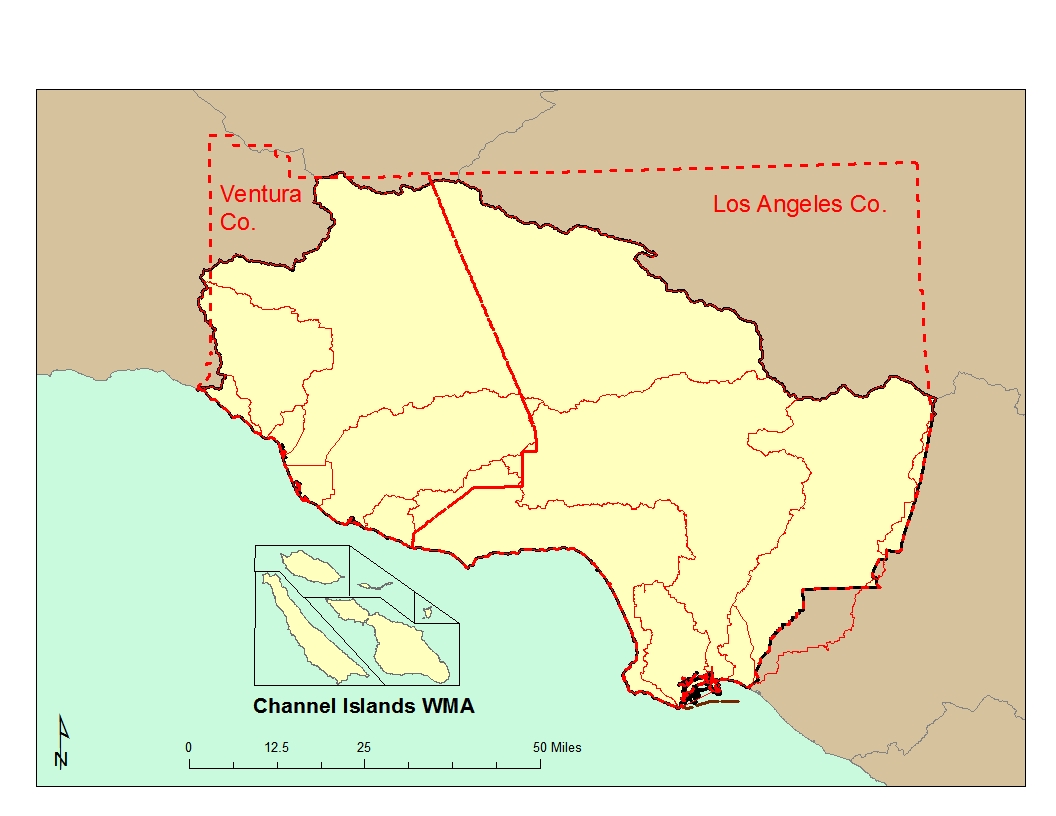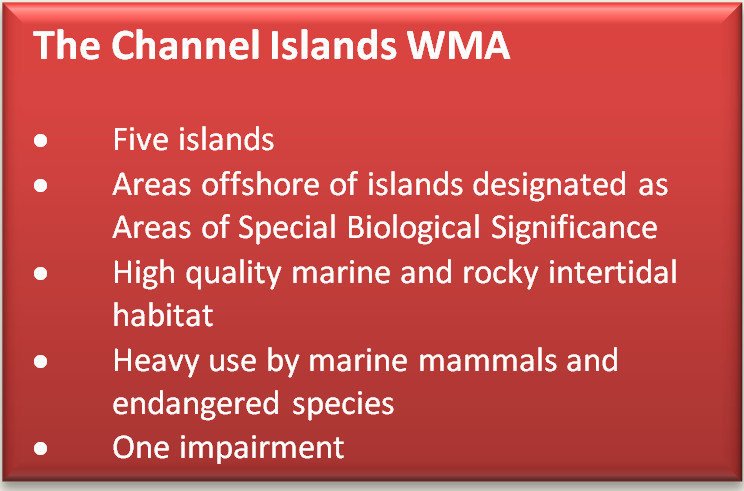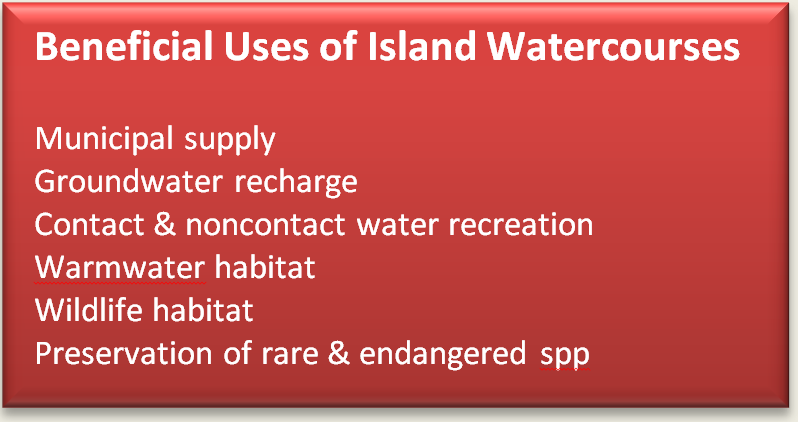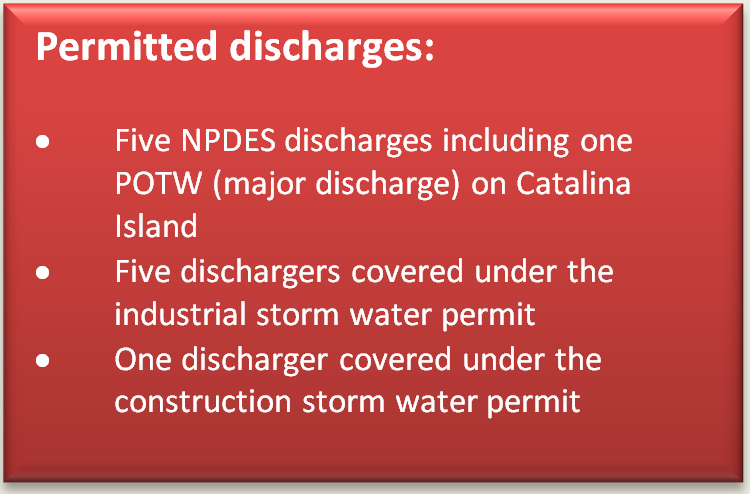
Watershed Description
The Channel Islands within the Region's boundaries are: Anacapa, San Nicolas, Santa Barbara, Santa Catalina, and San Clemente Islands. Anacapa and Santa Barbara Islands are part of the Channel Islands National Park. The waters within six nautical miles of Anacapa and Santa Barbara Islands are designated a national marine sanctuary. The ocean waters adjacent to the islands (not the entire circumference of Santa Catalina however) were designated Areas of Special Biological Significance (ASBS) by the state of California. The west side of San Nicolas supports a large gull rookery and elephant seal breeding area. The U.S. Navy has facilities on San Nicolas (and a desalination plant) and San Clemente Islands with a small package treatment plant on the latter. San Clemente Island is the primary maritime training area for the U.S. Department of the Navy Pacific Fleet, U.S. Navy SEALs, and the U.S. Marine Corps. The city of Avalon is located on Santa Catalina Island and also has a small treatment plant.
The west side of San Nicolas supports a large gull rookery and elephant seal breeding area. The U.S. Navy has facilities on San Nicolas (and a desalination plant) and San Clemente Islands with a small package treatment plant on the latter. San Clemente Island is the primary maritime training area for the U.S. Department of the Navy Pacific Fleet, U.S. Navy SEALs, and the U.S. Marine Corps. The city of Avalon is located on Santa Catalina Island and also has a small treatment plant.
There are condition reports available for the marine sanctuary portion of the Channel Islands at http://sanctuaries.noaa.gov/science/condition/cinms/welcome.html.
 Water Quality Problems and Issues
Water Quality Problems and Issues
Water quality in the vicinity of the islands is generally good.  There are some potential threats from naval facilities and small treatment plants; however, there is only one area (Avalon Beach) with an impairment listing, for bacteria on the 2010 303(d) list.
There are some potential threats from naval facilities and small treatment plants; however, there is only one area (Avalon Beach) with an impairment listing, for bacteria on the 2010 303(d) list.
Three of the five NPDES dischargers are located on Catalina Island including the one major discharge, a POTW. There are five dischargers enrolled under the general industrial storm water permit, all on Santa Catalina Island. One discharger is enrolled under the general construction storm water permit, on San Clemente Island.
Regional Board Actions to Address Impairments
A number of Regional Board programs and actions are in place to address the water quality impairments noted earlier.
Total Maximum Daily Loads (TMDLs) have been developed (as required by the Clean Water Act) for many of the impairments in the watershed. The TMDL is a number that represents the assimilative capacity of a receiving water to absorb a pollutant and is the sum of the individual wasteload allocations for point sources, load allocations for nonpoint sources plus an allotment for natural background loading, and a margin of safety. TMDLs can be expressed in terms of mass per time (the traditional approach) or in other ways such as toxicity or a percentage reduction or other appropriate measure relating to a water quality objective. A TMDL is implemented by reallocating the total allowable pollution among the different pollutant sources (through the permitting process or other regulatory means) to ensure that the water quality objectives are achieved. A TMDL in effect for the City of Avalon on Catalina Island (through issuance of a cease and desist order to the City) is one for bacteria. Additional information on TMDLs may be found at https://www.waterboards.ca.gov/losangeles/water_issues/programs/tmdl/.
Stormwater in other parts of the Region is being addressed through adoption of NPDES stormwater permits issued by the Regional Board to either individual municipalities or to a group of co-permittees under Phase I of the program. This first phase addresses larger municipalities (serving more than 100,000 people). Phase II of the stormwater program addresses stormwater from small Municipal Storm Sewer Systems (MS4s) through coverage by a general permit adopted by the State Water Board. The City of Avalon is a Phase II permittee. The 2013 Small MS4 permit specifies actions necessary to reduce the discharge of pollutants in storm water to the Maximum Extent Practicable. The permit also includes Low Impact Development requirements and Special Protections for discharges of storm water to ASBSs that were recently adopted by the State Water Board in order to ensure natural water quality is maintained. More information can be found on the State Water Board website at https://www.waterboards.ca.gov/water_issues/programs/stormwater/phase_ii_municipal.shtml.